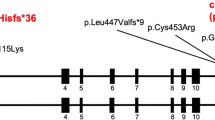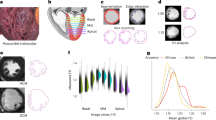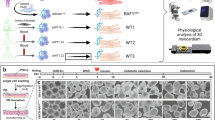Abstract
Deletions that include the gene TAB2 and TAB2 loss-of-function variants have previously been associated with congenital heart defects and cardiomyopathy. However, other features, including short stature, facial dysmorphisms, connective tissue abnormalities and a variable degree of developmental delay, have only been mentioned occasionally in literature and thus far not linked to TAB2. In a large-scale, social media-based chromosome 6 study, we observed a shared phenotype in patients with a 6q25.1 deletion that includes TAB2. To confirm if this phenotype is caused by haploinsufficiency of TAB2 and to delineate a TAB2-related phenotype, we subsequently sequenced TAB2 in patients with matching phenotypes and recruited patients with pathogenic TAB2 variants detected by exome sequencing. This identified 11 patients with a deletion containing TAB2 (size 1.68–14.31 Mb) and 14 patients from six families with novel truncating TAB2 variants. Twenty (80%) patients had cardiac disease, often mitral valve defects and/or cardiomyopathy, 18 (72%) had short stature and 18 (72%) had hypermobility. Twenty patients (80%) had facial features suggestive for Noonan syndrome. No substantial phenotypic differences were noted between patients with deletions and those with intragenic variants. We then compared our patients to 45 patients from the literature. All literature patients had cardiac diseases, but syndromic features were reported infrequently. Our study shows that the phenotype in 6q25.1 deletions is caused by haploinsufficiency of TAB2 and that TAB2 is associated not just with cardiac disease, but also with a distinct phenotype, with features overlapping with Noonan syndrome. We propose the name “TAB2-related syndrome”.
This is a preview of subscription content, access via your institution
Access options
Subscribe to this journal
Receive 12 print issues and online access
$259.00 per year
only $21.58 per issue
Buy this article
- Purchase on SpringerLink
- Instant access to full article PDF
Prices may be subject to local taxes which are calculated during checkout



Similar content being viewed by others
References
Thienpont B, Zhang L, Postma AV, Breckpot J, Tranchevent L, Van Loo P, et al. Haploinsufficiency of TAB2 causes congenital heart defects in humans. Am J Hum Genet. 2010;86:839–49.
Cheng A, Dinulos MBP, Neufeld‐Kaiser W, Rosenfeld J, Kyriss M, Madan‐Khetarpal S, et al. 6q25.1 (TAB2) microdeletion syndrome: congenital heart defects and cardiomyopathy. Am J Med Genet Part A. 2017;173:1848–57. Jul.
Ritelli M, Morlino S, Giacopuzzi E, Bernardini L, Torres B, Santoro G, et al. A recognizable systemic connective tissue disorder with polyvalvular heart dystrophy and dysmorphism associated with TAB2 mutations. Clin Genet. 2018;93:126–33.
Chen P, Yin J, Yu H, Yuan T, Fernandez M, Yung CK, et al. Next-generation sequencing identifies rare variants associated with Noonan syndrome. Proc Natl Acad Sci USA. 2014;111:11473–8. 8-5.
Engwerda A, Frentz B, den Ouden AL, Flapper BCT, Swertz MA, Gerkes EH, et al. The phenotypic spectrum of proximal 6q deletions based on a large cohort derived from social media and literature reports. Eur J Hum Genet. 2018;26:1478–89.
Swertz MA, Dijkstra M, Adamusiak T, van der Velde JK, Kanterakis A, Roos ET, et al. The MOLGENIS toolkit: rapid prototyping of biosoftware at the push of a button. BMC Bioinform. 2010;11:S12–S12. December 21Suppl 12.
Corsten-Janssen N, Bouman K, Diphoorn JCD, Scheper AJ, Kinds R, El Mecky J, et al. A prospective study on rapid exome sequencing as a diagnostic test for multiple congenital anomalies on fetal ultrasound. Prenat Diagn. 2020;40:1300–9.
de Ligt J, Willemsen MH, van Bon BW, Kleefstra T, Yntema HG, Kroes T, et al. Diagnostic exome sequencing in persons with severe intellectual disability. N Engl J Med. 2012;367:1921–9. November 15.
Terhal PA, Vlaar JM, Middelkamp S, Nievelstein RAJ, Nikkels PGJ, Ross J, et al. Biallelic variants in POLR3GL cause endosteal hyperostosis and oligodontia. Eur J Hum Genet. 2020;28:31–39. January 01.
Van Der Burgt I, Berends E, Lommen E, Van Beersum S, Hamel B, Mariman E. Clinical and molecular studies in a large Dutch family with Noonan syndrome. Am J Med Genet. 1994;53:187–91. Nov 1.
Nowaczyk MJM, Carter MT, Xu J, Huggins M, Raca G, Das S, et al. Paternal deletion 6q24.3: A new congenital anomaly syndrome associated with intrauterine growth failure, early developmental delay and characteristic facial appearance. Am J Med Genet Part A. 2008;146A:354–60. Feb 1.
Meloni VA, Guilherme RS, Oliveira MM, Migliavacca M, Takeno SS, Sobreira NLM, et al. Cytogenomic delineation and clinical follow‐up of two siblings with an 8.5 Mb 6q24.2‐q25.2 deletion inherited from a paternal insertion. Am J Med Genet Part A. 2014;164:2378–84. Sep.
Cheng A, Neufeld-Kaiser W, Byers PH, Liu YJ. 6q25.1 (TAB2) microdeletion is a risk factor for hypoplastic left heart: a case report that expands the phenotype. BMC Cardiovas Disord. 2020;20:137. Mar 17.
Caselli R, Mencarelli MA, Papa FT, Uliana V, Schiavone S, Strambi M, et al. A 2.6 Mb deletion of 6q24.3–25.1 in a patient with growth failure, cardiac septal defect, thin upperlip and asymmetric dysmorphic ears. Eur J Med Genet. 2007;50:315–21.
Salpietro V, Ruggieri M, Mankad K, Di Rosa G, Granata F, Loddo I, et al. A de novo 0.63 Mb 6q25.1 deletion associated with growth failure, congenital heart defect, underdeveloped cerebellar vermis, abnormal cutaneous elasticity and joint laxity. Am J Med Genet Part A. 2015;167:2042–51. Sep.
Bisgaard A, Kirchhoff M, Tümer Z, Jepsen B, Brøndum‐Nielsen K, Cohen M, et al. Additional chromosomal abnormalities in patients with a previously detected abnormal karyotype, mental retardation, and dysmorphic features. Am J Med Genet Part A. 2006;140A:2180–7. Oct 15.
Weiss K, Applegate C, Wang T, Batista DAS. Familial TAB2 microdeletion and congenital heart defects including unusual valve dysplasia and tetralogy of fallot. Am J Med Genet Part A. 2015;167:2702–6. Nov.
Stagi S, Lapi E, Pantaleo M, Carella M, Petracca A, De Crescenzo A, et al. A new case of de novo 6q24.2-q25.2 deletion on paternal chromosome 6 with growth hormone deficiency: a twelve-year follow-up and literature review. BMC Med Genet. 2015;16:69–z.
Permanyer E, Laurie S, Blasco-Lucas A, Maldonado G, Amador-Catalan A, Ferrer-Curriu G, et al. A single nucleotide deletion resulting in a frameshift in exon 4 of TAB2 is associated with a polyvalular syndrome. Eur J Med Genet. 2020;63:103854.
Chen J, Yuan H, Xie K, Wang X, Tan L, Zou Y, et al. A novel TAB2 nonsense mutation (p.S149X) causing autosomal dominant congenital heart defects: a case report of a Chinese family. BMC Cardiovasc Disord. 2020;20:27. Jan 20.
Caulfield TR, Richter JE, Brown EE, Mohammad AN, Judge DP, Atwal PS. Protein molecular modeling techniques investigating novel TAB2 variant R347X causing cardiomyopathy and congenital heart defects in multigenerational family. Mol Genet Genom Med. 2018;6:666–72. Jul.
Vasilescu C, Ojala TH, Brilhante V, Ojanen S, Hinterding HM, Palin E, et al. Genetic basis of severe childhood-onset cardiomyopathies. J Am Coll Cardiol. 2018;72:2324–38. Nov 6.
Ackerman JP, Smestad JA, Tester DJ, Qureshi MY, Crabb BA, Mendelsohn NJ, et al. Whole exome sequencing, familial genomic triangulation, and systems biology converge to identify a novel nonsense mutation in TAB2‐encoded TGF‐beta activated kinase 1 in a child with Polyvalvular Syndrome. Congenit Heart Dis. 2016;11:452–61. Sep.
Wade E, Daniel P, Jenkins Z, McInerney-Leo A, Leo P, Morgan T, et al. Mutations in MAP3K7 that Alter the activity of the TAK1 signaling complex cause frontometaphyseal dysplasia. Am J Hum Genet. 2016;99:392–406. Aug 4.
Wade EM, Jenkins ZA, Daniel PB, Morgan T, Addor MC, Adés LC, et al. Autosomal dominant frontometaphyseal dysplasia: Delineation of the clinical phenotype. Am J Med Genet Part A. 2017;173:1739–46.
McKusick-Nathans Institute of Genetic Medicine, Johns Hopkins University (Baltimore, MD). Online Mendelian Inheritance in Man, OMIM®. https://omim.org/. Accessed 1 July 2020.
Deelen P, van Dam S, Herkert JC, Karjalainen JM, Brugge H, Abbott KM, et al. Improving the diagnostic yield of exome- sequencing by predicting gene-phenotype associations using large-scale gene expression analysis. Nat Commun. 2019;10:2837–4.
Lepri F, De Luca A, Stella L, Rossi C, Baldassarre G, Pantaleoni F, et al. SOS1 mutations in Noonan syndrome: molecular spectrum, structural insights on pathogenic effects, and genotype–phenotype correlations. Hum Mutat. 2011;32:760–72.
Orelio C, Dzierzak E. Identification of 2 novel genes developmentally regulated in the mouse aorta-gonad-mesonephros region. Blood. 2003;101:2246–9. Jan 1.
Morlino S, Castori M, Dordoni C, Cinquina V, Santoro G, Grammatico P, et al. A novel MAP3K7 splice mutation causes cardiospondylocarpofacial syndrome with features of hereditary connective tissue disorder. Eur J Hum Genet: EJHG. 2018;26:582–6. Apr.
Zhang J, Macartney T, Peggie M, Cohen P. Interleukin-1 and TRAF6-dependent activation of TAK1 in the absence of TAB2 and TAB3. Biochem J. 2017;474:2235–48. June 26.
Acknowledgements
We would like to express our gratitude to all the children and families for their participation. We also thank Kate McIntyre for editing the manuscript and the members of the Groningen Genomic Coordination Centre. Our special thanks go to Pauline Bouman, our contact for the Chromosome 6 Facebook group.
Author contributions
Conceptualization: AE, CMAR, WSK; Data curation: AE; Funding acquisition: AE, BF, CMAR, WSK; Investigation: AE, CMAR, WSK; Methodology: AE, CMAR, WSK; Resources: AE, EKSML, BF, PAT, KL, BBAV, TD, YJV, TR, MPB, MTRR, WSK; Supervision: WSK; Visualization: AE, PD; Writing – original draft: AE; Writing – review & editing: AE, EKSML, BF, PAT, KL, BBAV, TD, YJV, TR, MPB, MTRR, CMAR, WSK.
Funding
This work was supported by a grant from ZonMw (113312101) and by crowd-funding organised by Chromosome 6 parents. AE is recipient of a Junior Scientific Masterclass MD/PhD scholarship of the University Medical Center Groningen.
Author information
Authors and Affiliations
Corresponding author
Ethics declarations
Competing interests
The authors declare no competing interests.
Ethical approval
The accredited Medical Ethics Review Committee of the University Medical Center Groningen waived full ethical evaluation because, according to Dutch guidelines, no ethical approval is necessary if medical information that was already available is used anonymously and no extra tests have to be performed.
Additional information
Publisher’s note Springer Nature remains neutral with regard to jurisdictional claims in published maps and institutional affiliations.
Supplementary information
Rights and permissions
About this article
Cite this article
Engwerda, A., Leenders, E.K.S.M., Frentz, B. et al. TAB2 deletions and variants cause a highly recognisable syndrome with mitral valve disease, cardiomyopathy, short stature and hypermobility. Eur J Hum Genet 29, 1669–1676 (2021). https://doi.org/10.1038/s41431-021-00948-0
Received:
Revised:
Accepted:
Published:
Issue date:
DOI: https://doi.org/10.1038/s41431-021-00948-0
This article is cited by
-
TAB2 deficiency induces dilated cardiomyopathy by promoting mitochondrial calcium overload in human iPSC-derived cardiomyocytes
Molecular Medicine (2025)
-
Genotyping arrays, population genetic studies and clinical implications
European Journal of Human Genetics (2021)



